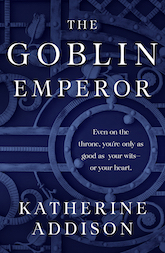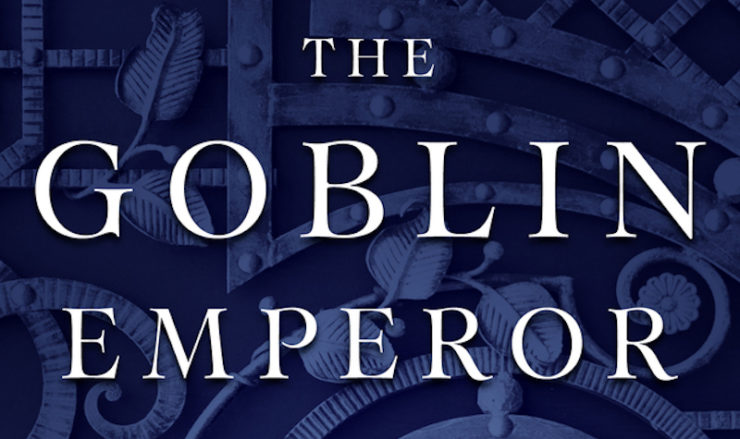The Goblin Emperor was first published in 2014, but I wrote it mostly much earlier than that. In my head, it’s a ten-year-old book, not a five-year-old book; it sometimes feels very far away. Working on another novel set in the same world is a good excuse to revisit The Goblin Emperor and to make a list of my five favorite things.
The Pneumatic Tube System
I love pneumatic tubes for no particular reason, except that they seem very steampunkish, and after a friend who worked in a hospital for a while told me about that hospital’s still working pneumatic tube system, I was consumed with the desire to create a massive building with a massive pneumatic tube system of its own.
And one of the things I love about world-building is that things have ramifications. If there’s a pneumatic tube system that’s a little like a subway system for messages, then there have to be stations, and if there are stations, there have to be the pneumatic equivalent of switchboard operators, which turns out to be in this world, as in ours, a profession that women can go into without anybody raising an eyebrow. It would be fun—if exhausting—to write a story from one of the pneumatic operators’ point-of-view.
Csethiro
I enjoyed writing Csethiro because she was a chance to play with prejudices and stereotyping on both sides. Maia’s intimidated by who he thinks she is, and she’s written Maia off as deadweight based on faulty intelligence. This leads to one of the very few occasions in the book where Maia loses his temper:
“Serenity, Min Vechin is using you.”
“Of course she is,” Maia agreed.
Dach’osmin Ceredin’s eyebrows shot upward, and Maia was unable to keep his bitterness pent decently behind his teeth. “How stupid you must believe us to be, to think we are unable to discern that for ourself. We thank you.”
She looked as if she’d just been bitten by a cushion.
But what I like about Csethiro—and this is where I really started to like her—is that she’s capable of admitting that she’s wrong.
“Serenity, we did not mean—” She stopped herself, and he watched as her colorless skin flushed a hard, painful red. “We beg your pardon. You are correct, and we ought not to have spoken so.”
He isn’t who she thought, but then it turns out she isn’t who he thought, either. After he survives an attempt to depose him, she writes him a letter (which was tremendous fun to write, especially because it contrasted so well with the cold, dutiful letter she writes him earlier in the book), in which, among other things, she implicitly offers to fight a duel on his behalf:
The art of dueling was no longer much practiced among the elves—the Varedeise emperors had disapproved of it wholeheartedly as something fit only for goblins—and it had never been taught to women at all. Maia wondered whom Dach’osmin Ceredin had found to teach her and if her father had the least idea. It occurred to him that there was nothing even remotely dutiful about fighting a duel, and he found himself smiling.
Csethiro, like most of the female characters in the book, turns out to have hidden depths and secrets, and it was fun to discover a few of them.
The Emperors’ Names
I am a name-driven writer. I can’t write about a character if I don’t know their name (I’ve proved it several times), and the entire language system of the book grew, like a trumpet vine from a single sprout, from Maia’s name. But my favorite names to invent were the emperors’ long, formal, elaborate names: Edrevenivar, Edrethelema, Varevesena, Varenechibel, Edretanthiar, and of course Edrehasivar.
Buy the Book


The Goblin Emperor
Maia’s Aunts
One of the things that turned out to be delightful about having such a small on-stage world (consisting of a hunting lodge, an airship, a horsemarket, and several parts of a vast palace) was the freedom to invent things off-stage. Maia’s aunts were a way to point to those things, to show how much bigger the world was than what Maia could see.
- One of Maia’s aunts, the legitimate one, is a noblewoman with mental health problems.
- One of Maia’s aunts is a nun.
- One of Maia’s aunts is an army wife and minor courtier.
- One of Maia’s aunts is a sea captain’s wife.
- One of Maia’s aunts is a sea captain.
One of the problems with writing a strongly patriarchal society—which Maia’s society has to be in order for him to come to the throne, so if it’s not, there’s no story—is of course that the women’s roles are so restricted. All of my female characters suffer from this; most of them are trying to subvert the paradigm in some fashion, and the Great Avar’s other daughters have clearly made choices based on the rules of the game. But Shalean has kicked the table over. She was a chance to just get rid of all the gender expectations for one character’s worth of the novel. She owns her own ship, the Glorious Dragon. She has a wife in a different country. She has clearly broken the bounds of good Barizheise womanhood and is writing a completely new story.
The Model of the Bridge
This is my single favorite piece of description in the entire book (with the Great Avar’s traveling coach being a close runner-up):
Beneath the drape was a model of a section of a river—of the Istandaartha. There were tiny houses on one side and pasture on the other, with little black and white dairy cows grazing on green velvet. The road on each side was paved with tiny quartz pebbles, smooth and gleaming like cobbles after rain. The river banks were rocky, with twisted verashme trees showing defiant golden-red blossoms. The river itself was brown and roiling, rendered, he thought, with silk and clusters of fish scales. At one point, a tree trunk surged angrily out of the water; he was amazed at the impression of movement and ferocity, at how deftly the model-maker had conveyed the power of the Istandaartha.
And in the center of this marvel, the focus and anchor, was the bridge. To Maia’s eye, instantly adapted to the delicacy of the world the model showed, it was a massive thing, a brass and iron monster, four great square towers, two on each bank, throwing out arm after arm toward each other until they met and clasped claws in the middle. He saw, with a jolt that was not surprise, that the spars of the bridge had been engraved to suggest the claws he had fancied. He leaned closer and saw the ugly, benevolent faces of four tangrishi at the top of each tower.
[…] As he looked closer, he could see that there were tiny people among the houses: a woman hanging laundry, a man weeding his vegetable garden, two children playing hider and seeker. There was even a tiny tabby cat sunning itself in a window. On the road toward the bridge, a wagon pulled by two dappled horses had stopped while the driver rummaged for smoething beneath his seat. Looking at the other side of the river, Maia suddenly spotted the cowherd among the cows, and he barely restrained a crow of delight. The cowherd, goblin-dark, was sitting cross-legged beneath the only tree in the pasture and playing a flute so carefully rendered that each fingerhole was distinctly visible.
I love this description because it was something that I could make as detailed as I wanted to and trust that the clockmakers, building this panorama to present to the emperor, would have gone that extra mile to put in the tabby cat and the cowherd while at the same time making a fully operational model of this insane clockwork bridge. I knew that someone would have labored over making the river seem properly powerful and dangerous. I knew that someone would have thought of having traffic on the road. I knew that someone would have figured out how to make tiny verashme trees.
(This model also saved my bacon. Because it demonstrates the bridge, I never had to come up with any sort of an explanation of how the dang thing works.)
It was also fun to have this tiny world-within-a-world, to suggest some of the ordinary life of his subjects that of course the emperor never sees. And it was fun to give this present to my poor protagonist, to give him one thing that he could be awe-struck by, one tiny crack to let his sense of wonder shine through.
Katherine Addison’s short fiction has been selected by The Year’s Best Fantasy and Horror and The Year’s Best Science Fiction. She lives near Madison, Wisconsin.










